Email Risk Assessment for Reducing Email Bounce Rates
Do you need help with email bounce rates? Your email list quality is the likely culprit. Complete our quick seven-question email risk assessment and get to the bottom of your email sender reputation.
Try it now →
Taking the email risk assessment
If you’re unsure about any assessment questions or need help with some of the terminology, use these tips to get help finding your risk score for emails.
How often do you update your email list?
Updating your email list is critical for preventing email deliverabilityⓘA sender’s ability to reach the recipient’s inbox with their outgoing emails. It may also describe the ratio of emails delivered to the inbox vs. those sent to spam or blocked by the receiving server. optimization. However, the frequency you need to update may differ depending on your email marketing efforts.
- Frequently - You update your email list at least monthly. Your brand enjoys a strong email list growth rate (higher than 2.5%) and needs to work harder to maintain email list hygieneⓘThe act of or ability to maintain an email list or database consisting of valid and active email addresses.
- Sometimes - Select this option if you update your email list at least quarterly
- Rarely - Select this option if you never, or seldom, update your email list
Do your emails often contain spam trigger words?
Certain words and phrases are more likely to trigger spam filters when you email subscribers. Email and internet service providers (ESP and ISP, respectively) help combat low-quality, spammy content from untrustworthy senders by using such word lists.
Examples of spam trigger words and phrases

Cheap

Giveaway

Promotion

X% off

Call now

Earn cash now

You’re a winner

Increase sales

Sign up free today

Free gift
You may use spam trigger words without realizing it (some are specific to industries), which can add to your email spam score. Using these triggers frequently impacts your email spam score evaluation and makes your content more likely to land in the corresponding folder.
Look at some of your recent email campaigns and cross-reference them with this master list of email spam trigger words
Learn more about spam, where it comes from, and what you can do to alleviate it.
Learn MoreHave you ever had issues with your IP reputationⓘA score used by internet service providers to approximate the reliability and trustworthiness of an IP address.?
If you’ve had issues with email IP reputation, you’ve likely received a notification from your ESP or ISP. Your IP is just one part of your overall email sender reputation.
IP reputation is a score that measures the quality of your email behaviors when using your IP. Factors that influence this include:
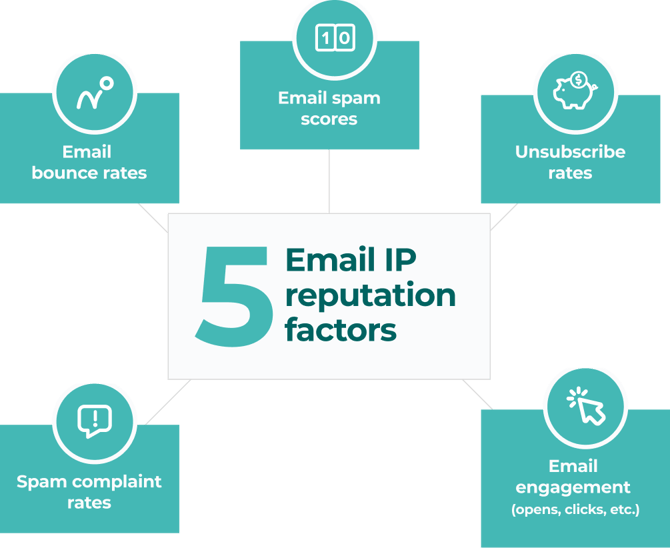
If you use a public IP, you’ll likely share an IP reputation with other senders (domains) that use the same IP. To help with assessing email risk, review your IP history and answer the prompt accordingly.
Curious about your IP reputation? Scan yours for free now.
Try reputation monitoringHave you ever had issues with your domain reputation?
Like the above question, failure to use email deliverability best practices also negatively impacts domain reputation.
While IP reputation refers to the origin of the email content, domain reputation identifies the company sending it and its corresponding behavioral patterns.
If you regularly cold email users who did not opt into your list, bounce emails, and rack up spam complaints, it’s a matter of time before you have an issue with your domain reputation.
Note that both IP reputation and domain reputation contribute to your overall email deliverability score.
Have you ever had issues with your email server’s configuration?
Email server configuration issues typically become apparent when you struggle to send or receive emails using your domain or IP.
These errors can occur in various areas, including email authenticationⓘOne or more techniques or policies created to help internet service providers determine the identity of an email sender as legitimate. Examples of email authentication include SPF, DKIM, DMARC, and BIMI. alignment (DKIM, SPF, DMARC), simple mail transfer protocol settings (SMTP), or within your DNS record settings.
If you’re unsure if you have email server configuration issues, our email server testerⓘA tool that analyzes all components that make up an email server and provides both cautionary and critical warnings based on the results. The tester examines header information, DNS records, email ports, authentication alignment, domain signing policy, and RFC document standards. can provide you with a variety of checks regarding the following:
- Header information
- RFC-based testing
- DNS record checks
- Email port checks
- DMARC Analysis
- SPF, DKIM, DMARC alignment
Need to test your email server configuration? Sign up to test yours at no charge.
Test your configurationDo you use email verification tools?
You can’t calculate email risk without addressing your email list hygiene.
Email verification is the best way to improve and optimize email list quality. It achieves this by determining if a contact’s email address is accurate and used by an actual subscriber. These tools can clean your list in bulk or real time by identifying and eliminating invalid or high-risk email addresses like disposable emailsⓘA temporary email address that users can create using a temporary email website or creation tool. You can use a disposable email address for a brief period before it expires and becomes invalid. or known spam complainers.
Do you have a double opt-in subscription process?
Double opt-in is a tried and true method email marketers use to improve email list quality.
The process works like this:
- User signs up for your email list, offer, promo, etc.
- You auto-send a confirmation email asking the person to confirm their signup.
- The user is finally added to your email list.
The double opt-in can help you eliminate bot-created emails, spammers, and other unwanted addresses from making it onto your email list. It can also help weed out real users who don’t want to subscribe and are unlikely to engage with your email content.
Reviewing your email risk assessment results
After completing the assessment, we’ll provide a total score describing your email risk level.
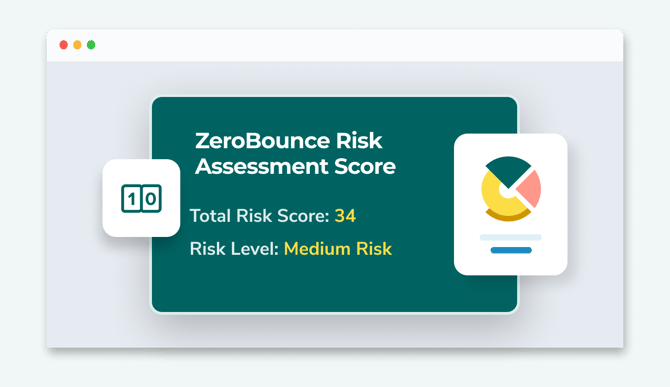
It’s worth noting that past issues do not necessarily indicate a present risk.
For example, if you had issues with email server configuration but successfully resolved them, your email deliverability should be in good shape. However, regularly testing your configuration is a great way to stay proactive in avoiding delivery issues.
However, your answers in other areas may suggest a more pressing threat.
First, companies should update their email list regularly (at least once per quarter). If you’re not checking and updating your email list, problems are inevitable. Email lists decay annually by at least 23%.
If you’re not updating your list, likely you’re not verifying emails, either. As email addresses decay, you’re more likely to bounce emails, pick up spam complaints, and encounter more email deliverability issues.
As these problems compound, you’ll encounter issues with your email sender reputation. If you’ve already had issues with IP or domain reputation in the past, new issues may affect you more negatively. A history of poor email hygiene and sending habits factor into your email sender reputation and will destroy any opportunity to build your email marketing ROI.
Email deliverability best practices
Any risk to your email reputationⓘAlso referred to as ‘Sender Reputation.’ This describes how trustworthy a sender is when sending emails. Reputation is influenced by past campaign performance and sending habits, including bounce rate, spam complaints, abuse reports, email authentication, sending volume, and domain history. is worth addressing. If our email risk assessment shows that you’re at risk, review these email deliverability practices to determine what to do next.
Clean your list
First and foremost, you can improve the quality of your email list by cleaning it today.
All you need to do is download your list of email contacts. Then, upload your file to your email verification service of choice.
During the process, your email verifier will examine each email address and determine the type of email. The goal is to clean and optimize your email list to only contain “valid” emails. This means that the address exists on the corresponding domain, and you can successfully deliver content to the destination.
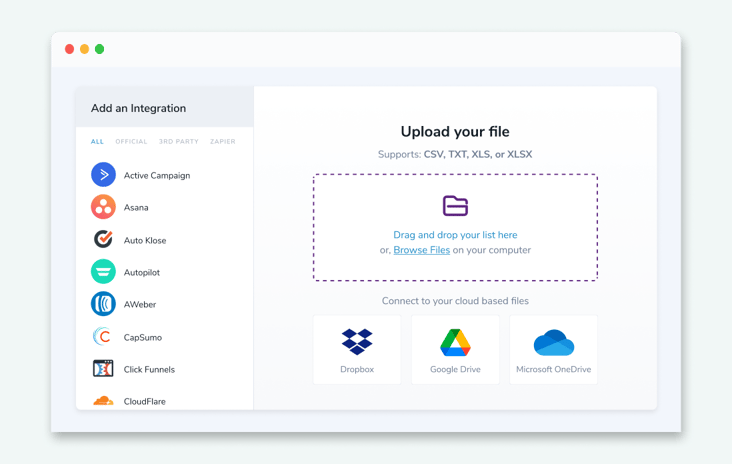
Email list cleaningⓘThe process of removing invalid and high-risk emails, such as spam traps or disposable emails, from an email list. Email list cleaning can be performed after gathering data via email validation. is crucial, as just a few risky email addresses can affect how you calculate email risk. Here’s why it’s easy to pick up harmful emails.
5 Factors That Influence Email List Quality
Emails decay
Email changes, job shifts, promotions, etc.
Privacy concerns
It takes just minutes for a disposable email to become invalid
Spam complainers
People that complain instead of unsubscribe
Spam traps
Spam prevention services are on the lookout for bad actors
Catch-alls
Technically valid but often aren’t configured to receive mail.
Want to try our email verifier? Upload up to 100 email contacts free when you create your free account!
Try ZeroBounce FreeEmploy a double opt-in process
As described above, you should use a double opt-in if you need visitors or customers to register by email.
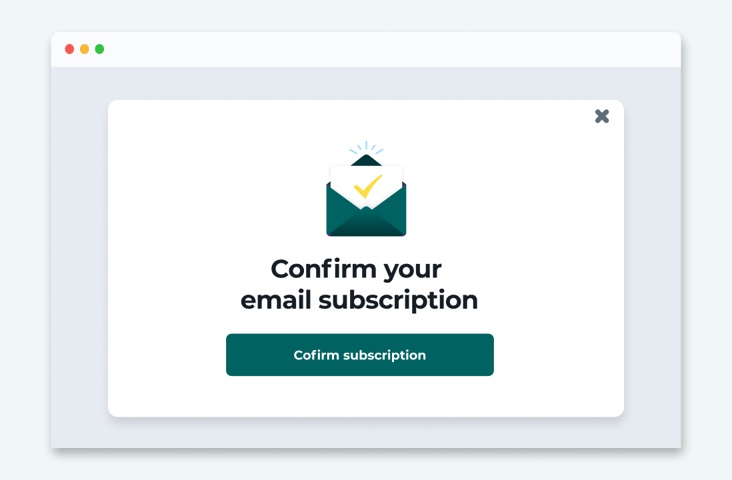
Using a double opt-in not only wards away low-quality and invalid email addresses but can help boost overall engagement. Subscribers who confirm that they want your content are more likely to open your future emails.
Avoid spam trigger words when possible
Though seemingly self-explanatory, avoiding spam trigger words can be tricky. After all, sometimes you have an excellent offer or promotion you want people to know about!
The key here is to avoid using these phrases as much as possible. If you must use a word that matches a typical spam trigger list, use them organically. There’s a clear distinction between a retailer’s typical holiday discount promo versus a spam message stuffed to the gills with fluff that you’d find in your spam folder.
However, not all inboxes react the same way to spam folders. That’s why it’s great to test your inbox placement before you hit send to reduce email spam score and land in the inbox reliably.
Want to see where your email lands? Test your inbox placement now with ZeroBounce!
Test my inbox placementUse real-time email validationⓘA process that determines if an email address uses valid syntax, exists on a given domain, and is configured to receive incoming email messages
What’s better than cleaning your email list in bulk? Stopping invalid, risky emails from ever entering your database.
Some email verifiers offer their services via an API. This feature allows you to optimize your email list proactively by blocking invalid emails at registration. Add the user-friendly API to your website or landing pages and block risky emails automatically.
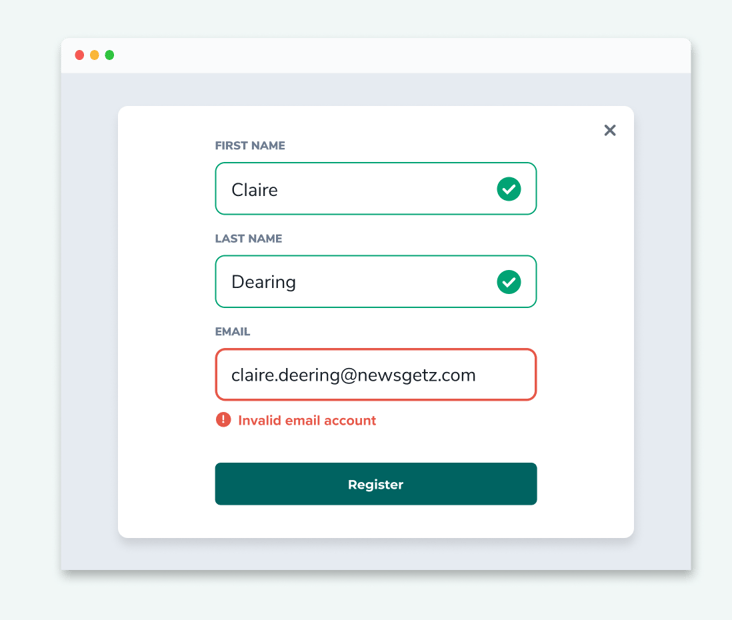
It’s effective, too. In 2023, ZeroBounce verified over 6 billion emails. Of those cleaned using real-time verification, 26% were invalid. That’s 1 in 4 harmful email addresses blocked from entering your list.
Optimize email lists with Email FinderⓘA tool that allows users to look up an email address by using either a name, an email domain, or a combination of both data points.
Finally, you can replace outdated email data and fill out incomplete contact cards using an email finder tool.
It’s important to note that you should never use an email finder to look for and start emailing just any contact. Those individuals must subscribe to your email list for you to begin sending content or risk damaging your email sender reputation. Legally, you must also ensure that they have a way to unsubscribe from your content immediately.
However, it’s not uncommon to fall out of touch with business contacts, primarily when you deal with a high volume of calls and emails. An email finder can help you connect with the right people if you can provide a name and domain.
Want an email finder that verifies new addresses with 99% accuracy? Try ZeroBounce today.
Get 10 free Email Finder queriesBenefits of improving email list quality
Performing a regular email risk assessment is critical for better email marketing results. Here’s what you can look forward to when you devise an effective strategy to minimize your email risk.
Minimize email bounce rates
Email bounce rates are the bane of any company or email marketer. If you can’t deliver your emails, you can’t convert your subscribers into customers.
All of the above strategies will profoundly impact your email bounce rate. Cleaning your email list regularly ensures that your addresses belong to real people. You can further boost this benefit by using real-time verification on your signup forms to block invalid and disposable emails. It will also help prevent common issues like misspellings and typos.
Improve email deliverability
With a low email bounce rate (ideally below 2%), your email deliverability will improve overall.
Delivered and deliverability don’t necessarily mean the same thing. Even if your emails reach their destination, they may end up in the spam folder if you have domain or IP reputation issues. Low bounce rates let ISPs know you’re a trustworthy sender, making them more likely to accept and place your emails in the inbox.
Maintain email sender reputation
Those email deliverability best practices will also boost your sender reputation, including both IP and domain reputation improvement.
For starters, regularly testing your email server configuration can ensure your emails reach their target. Proper implementation of email authentication tactics like DMARC, SPF and DKIM can also help protect your domain and IP from threats that might otherwise hijack both for spamming and spoofing purposes.
Email engagement improvements
Email list updates and email deliverability optimizationⓘThe act of diagnosing and improving email list health and domain reputation factors that determine the likelihood that an email message will reach the inbox. deliver more email campaign activity.
Emailing valid contacts, avoiding common spam words, using proper configuration, and employing a double opt-in will improve your subscriber engagementⓘA measurement that describes how much or how often email list subscribers interact with an email message.. More emails reach more people, giving your audience more chances to enjoy your content.
More importantly - your email campaigns can now provide actionable feedback. With best practices, you can assess performance accurately, such as your subject lines, email layout, or content. Your subscribers are getting your emails, and now you can focus on which ones they enjoy the most.
Eliminate email risk with ZeroBounce
Anyone can start with email deliverability optimization by taking advantage of the abovementioned strategies. You don’t need to be an expert or have any technical knowledge to minimize your bounce rate and improve your email sender reputation.
However, choosing the right partner can make it even easier.
ZeroBounce provides tools dedicated to assessing email risk and improving your campaigns. Our dashboard provides everything an email marketer needs, including:
- Email verification
- Reputation monitoring
- Inbox placement testingⓘA process that allows users to analyze how an email performs with various email service providers before sending the campaign to a real audience. The test identifies errors with the header, body, and footer to help users remedy problems that prevent them from reaching the inbox.
- Email server configuration testing
- Email Finder
- Activity Data, Email ScoringⓘA ZeroBounce service that uses AI and proprietary technology to grade an email contact based on their likelihood to interact with an email and convert (most commonly used for catch-all email addresses)., and more
Create your free account now and test our entire platform for free, including 100 verification credits to improve your email list quality.
Try ZeroBounce FreeFrequently asked questions
An email risk assessment determines the danger associated with a sender’s email content, email database, email server configuration, and sender reputation. Email risk not only impacts the person receiving any risky email content but also impairs the sender’s ability to send and receive future email content.
You can reduce email bounce rates by using email deliverability best practices. These tactics include cleaning your email list with an email verifier, installing a real-time email verifier on your registration forms, properly configuring your email server, and avoiding common spam trigger words.
Email sender reputation is a score internet service providers use to determine the email behavioral quality of a domain and IP. Factors that impact your reputation include email bounce rate, spam complaint rate, open rate, and click rate. A positive email sender reputation improves email deliverability and inbox placement, while a negative reputation makes your emails more likely to bounce or land in spam.
Spam trigger words are keywords or phrases that internet service providers use to identify the likelihood of spam content. These warning signs place your emails under high scrutiny and are less likely to reach a user’s inbox. Examples of spam trigger words include “free gift,“ “fast cash,“ “lowest price,“ “trial,“ or “no hidden fees“.
Spam score is a number generated by spam filters after comparing your email content to typical email spam traits. Factors that impact your spam score include using spam trigger words, the email’s HTML and content structure, and email sender reputation. A high spam score makes it more likely for that email to land in the spam folder.